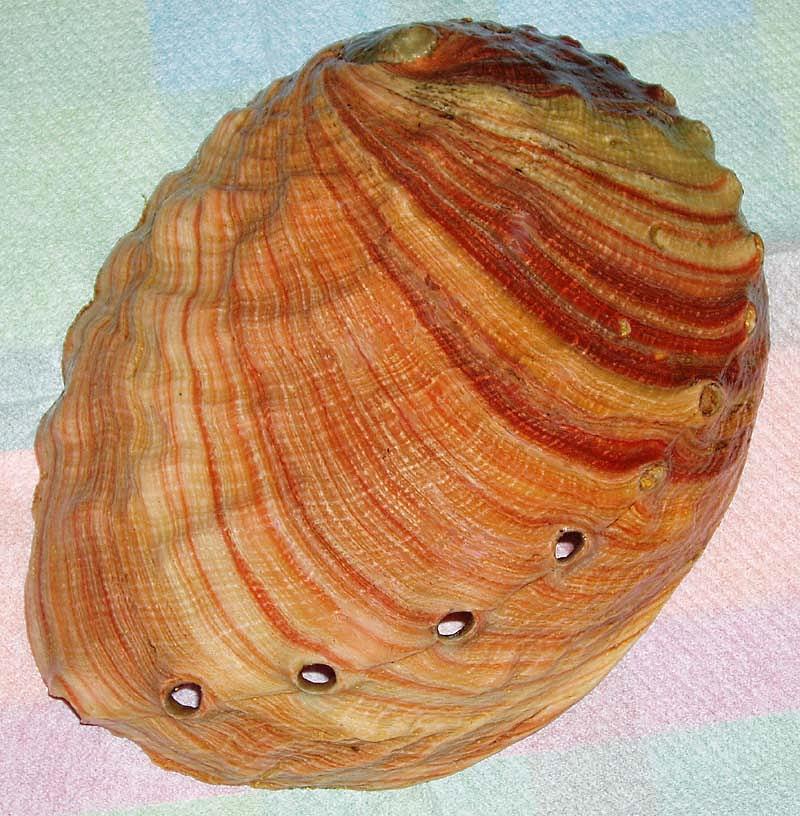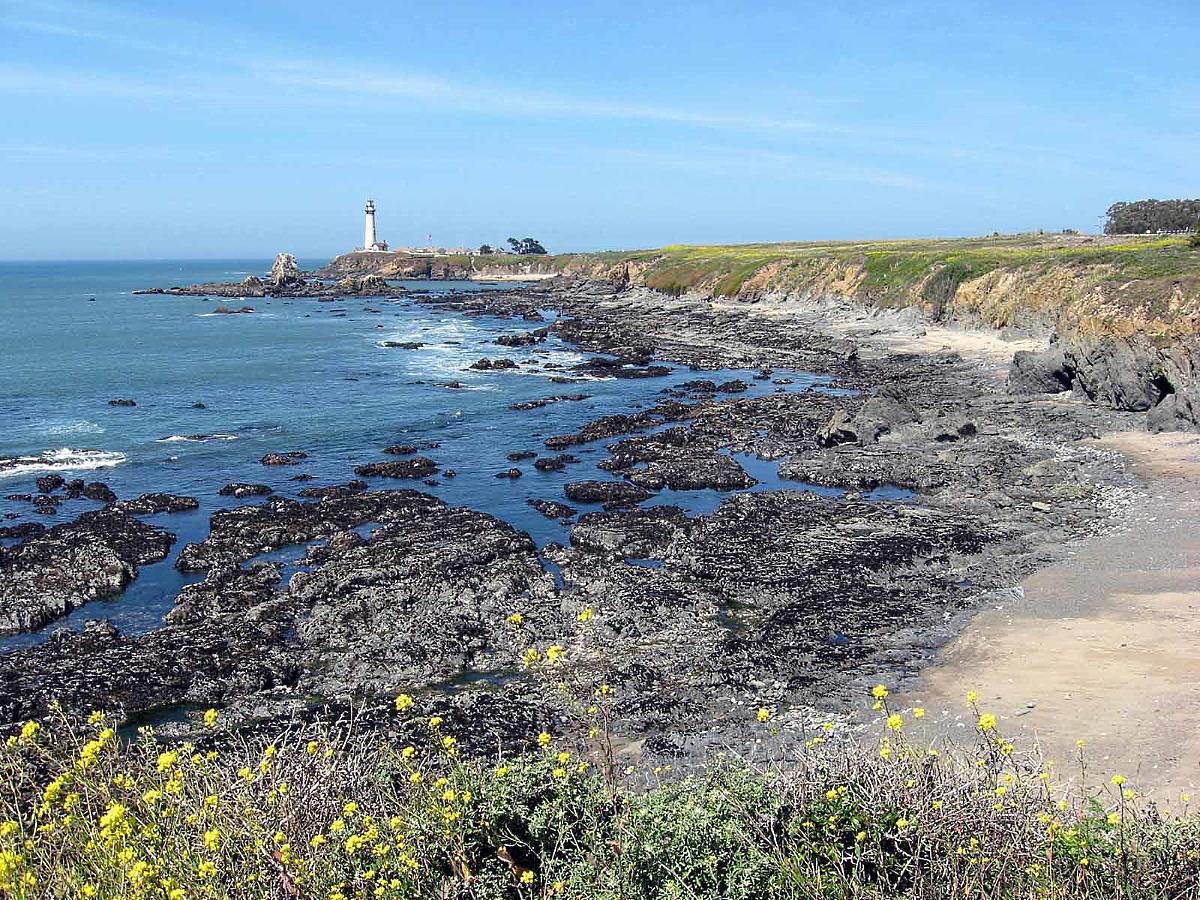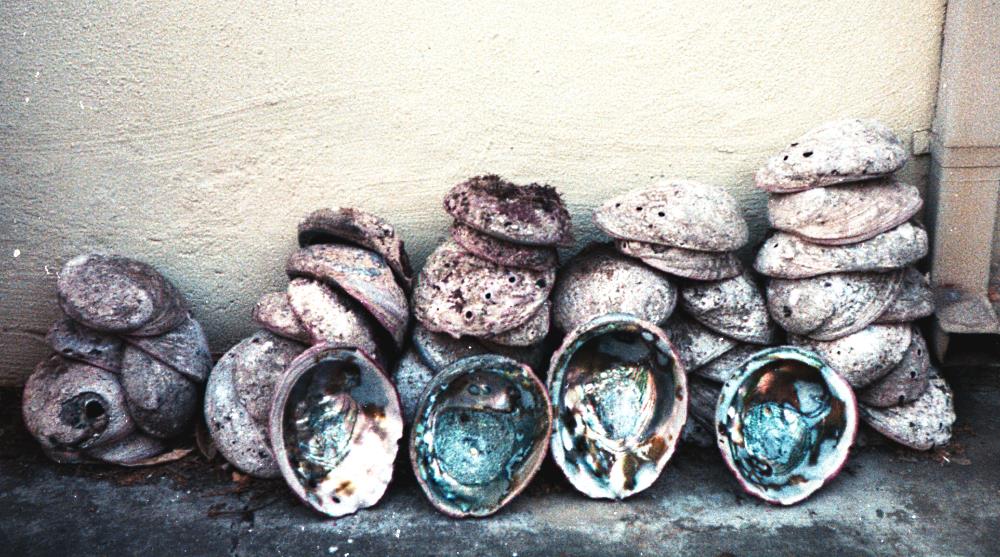
CopyRight @ 1998
Pidgin Point got its name from the liner Carrier Pidgin, that tested its hull against the rocks there. It is on the coast between Santa Cruz and San Francisco on the seaward side of the San Francisco Peninsula. It is about 30 miles north of Santa Cruz and about 5 miles past Ano Neuvo Island. That means that it is white shark central, well within the so called 'white triangle'. The coast there is a place of wind swept beauty beneath redwood covered slopes. It is a place of mists, winds, waves, sea weeds, rock, whale bones and open ocean. Its remoteness and harshness preserve its wild beauty. Its exposure to the currents make for lush diving.

The endless harsh, lush, beautiful reefs of Pigeon Point..
I probably spent more time diving at Pidgin Point than anywhere else I have ever visited.
There are two distinctly different areas to dive there. There are the
west facing shores north of the light house and the south facing beaches
below the light house. It can be rough on one side and fairly calm on
the other.
As you drive along the coast, there is a frontage road that starts
about a mile up on both sides of the light house. North of the light house,
the road goes perhaps a hundred feet from the waters edge and there is
easy access to entries all along the road. Mostly it is rock entries and
it is fully exposed to the north swell, so it is rarely calm. Still, this
side is a bit deeper and better for scuba, with decent visibility much of
the time. That means 10 to 30 feet on a decent day. People used to camp
along this beautiful shore, but they no longer allow it, though it is still
a great place to visit for day use.
The commonest place for divers to enter the water is at the small beach
that is the first accessible part of the shore, north of the fences of
the light house. It is easy to get to and a fairly easy entry... if you
are careful of the waves. There are lots of fish on the reefs and there
were lots of invertebrates before the otters got there. Still, there is
a lot to see there that the otters don't eat including sponges, stars and
hydrocorals. It is also an incredibly thick algae garden that is fun to
explore through. You never know what you will see if you look in the holes
under the rocks.
My place to dive though, was south of the light house. A few hundred yards south of the light house are areas of the frontage road where you can pull off onto the bluffs over the shore. The cliffs there are about 30 feet high and there are a number of ways down them to the small beaches of the shore. The good part about the south side is that it was often protected from the north and west swell. The bad part was that it was still exposed to the south swell. One other thing. Visibility there is a challenge. The geology of the area is called mudstone. 6 feet of vis is a pretty good day. Since I was mostly there to free dive for abalone though, it really didn't matter much. You spend your time swimming through rocks and thick kelp such that often you can't look more than a couple of feet anyway. Since the water is shallow, there is a lot of light and there is a lot to see.. Still, on a poor day, it is hard to see your outstretched hand. On a bad day, it was blackout on the bottom. Plankton blooms are serious in the nutrient rich waters there. Even on good days, fish watching tends to be eyeball to eyeball encounters under rocks.
I first went there with my intertidal algae classes. At low tide, the tide pools and tidal rocks extend far from shore. There is an incredible diversity of algae species. It is beautiful and crisp at the dawn low tide. There is a large rock starting near the shore that draws one to try to figure out how to get to it without getting into the cold water. The cove, protected just inside the point below the light house is like a lake. After seeing it once, I wanted to dive it. There was miles of reef to explore. Actually, it was a while before I did a lot of diving there though. I had found another very fun place closer to Santa Cruz. It was not until I decided that Greyhound Rock was too dangerous to dive that I really spent a lot of time at Pidgin.
I did a lot of diving in the protected cove, but so had a lot of other people. It was great swimming for hours in the calm waters. There were occasional abalone and some in front of the big rock. I knew a few good places to look, but really I knew that it was far less visited further south where it was less protected.

This is after many years of hunting the San Mateo Coast. Divers had hunted there for 40 years and size/take limits plus nasty weather kept the populations healthy. Otters have no limits. I have seen what they do and it is far worse than humans.
I learned the entries a few hundred yards south of the point. They could
be a challenge. The shore tended to drop off in shelves. First you had to
walk through the shallow rocks. Then you had to bounce through the shallows
and get to a swimming depth. That is serious surf zone though, so you have
to continue out to the areas between 6 and 12 feet. That is a great dive
zone. Beyond that there is more drop offs, but that area seriously belongs
to the landlord. Still, that allowed for an area 100 yards wide by miles
long and far more than I could explore.
Even though it is at best a surgey area and a wave zone at worst, since
you are swimming right on the bottom, usually between rocks, you don't
much notice the surge. Also, it is just part of the diving there and you
don't notice it. There is lots to hold on to and often that is just a
good idea.
I should mention that before you enter the water you look for sea lions.
If they are calm and sleeping, go diving. If they are panicked as they
occasionally were, you don't go in the water. I have seen whales swimming
along where the outer reef drops past 12 feet. They follow the contour of
the reef. I suspect that the great whites do too. While I never saw any
sharks there while I was diving, apparently a diver got hit and killed
just as I was driving away once. He had been resting on his float with
his legs hanging down. He was in 12 feet of water.
Then after you get tired exploring, swim on in to the tide pools where
the water is about 2 feet deep. It is great diving. It's so shallow that
effectively the visibility is unlimited. The sun makes the colors
brilliant. You just drift over the holes and cracks checking out the
anemones, crabs, shrimp, limpits, fish, algae, corallinas and other
inhabitants of this lush diverse shore.
At the Channel Islands, I had gotten comfortable freediving to 70
feet and had gone over 100. It made for lots of bottom time in these
shallow waters.
At this time, when I was in school, I didn't have a car, so I would get
my friend Dan to drive me up there. I would dive while he and Liz would
explore the beaches. The we would go back and have a cooking competition
mixed with an abalone eating competition.
The water is cold there, but diving with a light wetsuit, I never seemed
to get cold. Young is wonderful.
Actually, I think it might have been lucky that I was wearing a
light wetsuit with 1/8 inch sleeves. I habitually forgot my
weightbelt, but I would just find a flat rock and slide it in
up under the front of my sleeves.
This was also where I made my first memorable
Sudafed
dive. I was so blasted I didn't even know I was high.. until I
found myself somewhere that I didn't belong.
After school I went back to LA and visited the Channel Islands, but I love the Bay Area and the beauty of Northern California. I moved to San Jose after a few years. The journey getting there, following the Spring, via Santa Cruz, Humbolt County, Oregon and Yellowstone would make for a good story, but then I was there in San Jose, near my personal paradise, Santa Cruz. Maybe I'm just easy to please... or maybe there is just more to that story.
On a Friday night, I would drive my van to the bluffs south of the
light house. Pizza, donuts and a book were all I needed. Wake up. If it
was too rough, go back to Santa Cruz and
bodysurf.
Otherwise, gear
up and look for an entry I hadn't tried recently. The calmer the water,
the further south the entry. I might find a cave to try to explore or
offshore rocks to climb on. I might find sea lions that wanted to play.
I might find an elephant seal that completely ignored me. I might see
fish or invertebrates, common or rare with bright colors or drab. I
usually picked up a tasty dinner. Really though, it was guaranteed that
I would be rejuvenated by the wonders of the beautiful shallow reefs of
Pidgin Point.
